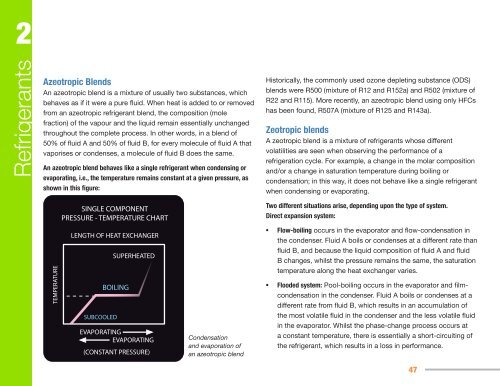Manual for Refrigeration Servicing Technicians - UNEP - Division of ...
Manual for Refrigeration Servicing Technicians - UNEP - Division of ...
Manual for Refrigeration Servicing Technicians - UNEP - Division of ...
You also want an ePaper? Increase the reach of your titles
YUMPU automatically turns print PDFs into web optimized ePapers that Google loves.
2<br />
Refrigerants<br />
Azeotropic Blends<br />
An azeotropic blend is a mixture <strong>of</strong> usually two substances, which<br />
behaves as if it were a pure fluid. When heat is added to or removed<br />
from an azeotropic refrigerant blend, the composition (mole<br />
fraction) <strong>of</strong> the vapour and the liquid remain essentially unchanged<br />
throughout the complete process. In other words, in a blend <strong>of</strong><br />
50% <strong>of</strong> fluid A and 50% <strong>of</strong> fluid B, <strong>for</strong> every molecule <strong>of</strong> fluid A that<br />
vaporises or condenses, a molecule <strong>of</strong> fluid B does the same.<br />
An azeotropic blend behaves like a single refrigerant when condensing or<br />
evaporating, i.e., the temperature remains constant at a given pressure, as<br />
shown in this figure:<br />
TEMPERATURE<br />
SINGLE COMPONENT<br />
PRESSURE - TEMPERATURE CHART<br />
LENGTH OF HEAT EXCHANGER<br />
SUBCOOLED<br />
SUPERHEATED<br />
BOILING<br />
EVAPORATING<br />
EVAPORATING<br />
(CONSTANT PRESSURE)<br />
Condensation<br />
and evaporation <strong>of</strong><br />
an azeotropic blend<br />
Historically, the commonly used ozone depleting substance (ODS)<br />
blends were R500 (mixture <strong>of</strong> R12 and R152a) and R502 (mixture <strong>of</strong><br />
R22 and R115). More recently, an azeotropic blend using only HFCs<br />
has been found, R507A (mixture <strong>of</strong> R125 and R143a).<br />
Zeotropic blends<br />
A zeotropic blend is a mixture <strong>of</strong> refrigerants whose different<br />
volatilities are seen when observing the per<strong>for</strong>mance <strong>of</strong> a<br />
refrigeration cycle. For example, a change in the molar composition<br />
and/or a change in saturation temperature during boiling or<br />
condensation; in this way, it does not behave like a single refrigerant<br />
when condensing or evaporating.<br />
Two different situations arise, depending upon the type <strong>of</strong> system.<br />
Direct expansion system:<br />
• Flow-boiling occurs in the evaporator and flow-condensation in<br />
the condenser. Fluid A boils or condenses at a different rate than<br />
fluid B, and because the liquid composition <strong>of</strong> fluid A and fluid<br />
B changes, whilst the pressure remains the same, the saturation<br />
temperature along the heat exchanger varies.<br />
• Flooded system: Pool-boiling occurs in the evaporator and filmcondensation<br />
in the condenser. Fluid A boils or condenses at a<br />
different rate from fluid B, which results in an accumulation <strong>of</strong><br />
the most volatile fluid in the condenser and the less volatile fluid<br />
in the evaporator. Whilst the phase-change process occurs at<br />
a constant temperature, there is essentially a short-circuiting <strong>of</strong><br />
the refrigerant, which results in a loss in per<strong>for</strong>mance.<br />
47

















